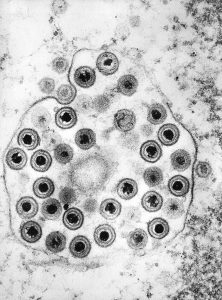The scientific community may be one step closer to stopping the spread of the herpes virus thanks to new Washington State University research.

Herpes simplex virus type 1 (HSV-1) is the most common cause of oral herpes which causes painful blisters better known as cold sores.
WSU researchers recently published a study in the American Society for Microbiology’s journal mSphere that is the first to identify how one of the virus’ proteins acts as a critical signaler for the virus to succeed in infecting a cell.
Herpes simplex virus type 1 invades the body through the epithelial cells that line human organs, including the skin. Once inside, the attack sequence is launched when a protein on the virus’ surface called glycoprotein C detects a change in the cell’s acidity level. A second protein called glycoprotein B then initiates the attack on the cell. “We may have identified a novel target for intervention because, in theory, if you can prevent that initial infection, you can avoid the virus,” said Tri Komala Sari, a WSU graduate student in the Department of Veterinary Microbiology and Pathology and the paper’s lead author.
Read more at Washington State University
- Ecuador reports 6 COVID-19 cases
- Italy coronavirus outbreak eclipses 2,000 cases
- Majority of Americans Believe They Will Contract the Coronavirus This Year: Survey
- COVID-19: King County reports more cases, deaths
- Iran COVID-19 outbreak tops 1500, Ayatollah Ali Khamenei advisor dies
- Rhode Island reports second presumptive positive COVID-19 case
- COVID-19 in Washington: 4 additional cases, 1 death in King County
- New York reports 1st COVID-19 case in traveler to Iran

